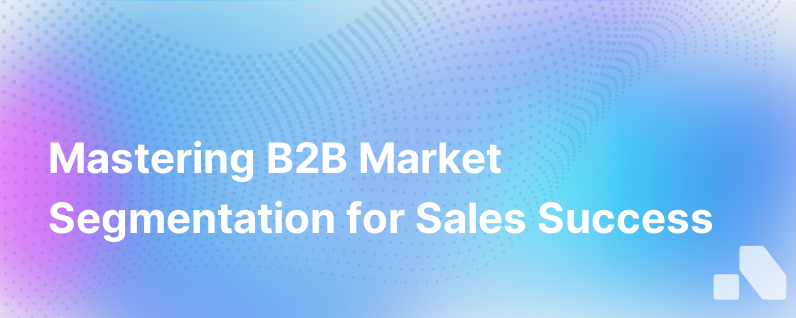B2B Market Segmentation
Published on November 8, 2023 by David Zhang
In the B2B space, market segmentation is a critical strategy that enables companies to precisely target their marketing efforts, ensuring they reach the appropriate audience with tailored messages that resonate. Unlike the B2C world, where broad segments are often identified by demographics such as age, gender, or income, B2B segmentation requires a more nuanced approach, considering factors such as industry, company size, and buyer role. This granular level of targeting is key to optimizing marketing resources, enhancing customer experience, and ultimately driving revenue growth. Let's dive deeper into the nuances of B2B market segmentation.
Why is B2B Market Segmentation Important?
1. Increased Targeting Precision
In the B2B arena, your buyers are businesses, each with unique needs, budgets, pain points, and purchasing processes. Market segmentation allows companies to identify and target specific groups with customized solutions, driving higher engagement and conversion rates.
2. More Effective Communication
Knowing your market segments allows you to tailor your communication to address specific business challenges and goals. This creates messages that are more relevant and compelling to your audience, rather than a one-size-fits-all approach.
3. Enhanced Product Development
Understanding the specific needs and preferences of different market segments can inform product development, leading to offerings that better serve your target audience's needs.
4. Better Allocation of Resources
When you understand your market segments, you can allocate marketing and sales resources more efficiently, focusing on the most profitable segments or those with the highest potential for growth.
5. Competitive Advantage
Well-executed market segmentation can differentiate your business from competitors by demonstrating a deeper understanding of, and commitment to, your customer's specific requirements.
Core Elements of B2B Market Segmentation
1. Firmographics
Firmographics are equivalent to demographics in B2C segmentation and include factors such as company size, revenue, location, industry, and the number of employees. They provide a high-level overview of potential markets and are typically the starting point for segmentation.
2. Customer Needs and Pain Points
Diving into the specific needs and challenges that customers face offers a more targeted form of segmentation. This can reveal untapped opportunities where your product or service solves a unique problem.
3. Buying Patterns and Processes
B2B purchasing processes are often complex, involving multiple touchpoints and stakeholders. Understanding these processes, including the typical buyer's journey and cycle length, can help tailor marketing efforts to align with how and when purchasing decisions are made.
4. Behavioral Data
Observing customer interactions with your company provides insights into how they engage with your business, which can refine segmentation. Metrics may include product usage patterns, website visits, and content engagement.
5. Customer Tiering
Segmenting based on profitability or potential value—to categorize customers into tiers—can help businesses identify key accounts that require premium service or upselling opportunities.
Building a B2B Market Segmentation Strategy
To effectively segment your B2B market, follow these strategic steps:
1. Gather and Analyze Data
The foundation of any segmentation strategy lies in robust data. Use all available resources—such as CRM systems, social media analytics, industry reports, and customer feedback—to build a data landscape.
2. Identify Segmentation Criteria
Determine which segmentation criteria are the most relevant to your business model and market. This could be a mix of firmographic factors, customer needs, purchasing behavior, and other industry-specific variables.
3. Create Segments
Use the identified criteria to create distinct market segments. These groups should be substantial enough to warrant targeted marketing efforts but specific enough to allow for personalization.
4. Profile Each Segment
Develop in-depth profiles for each market segment, detailing their characteristics, preferences, and behaviors. These profiles serve as the basis for targeted marketing campaigns and sales strategies.
5. Tailor Marketing Mix
Customize your marketing mix for each segment, aligning your product or service, price, place, and promotion to meet their unique requirements.
6. Test and Refine
Market segments are not static; they evolve with market changes and internal shifts. Continuously test and refine your segments to ensure they remain relevant. Adjust strategies based on performance data and feedback.
7. Align Sales and Marketing
Ensure that sales and marketing are aligned on segmentation strategy and execution. Consistency in messaging and approach is crucial for segment penetration and customer acquisition.
Best Practices for B2B Market Segmentation
1. Prioritize Customer-Centricity
A customer-centric approach ensures your segments are defined based on customers' needs and values rather than based on convenient firmographic cuts.
2. Integrate Technology
Employ technology solutions, including AI-powered analytics and CRM tools, to manage and analyze large datasets for more precise segmentation.
3. Account for Decision-Making Units (DMUs)
In B2B transactions, purchasing decisions are often made by a group (DMU). Account for the roles, influence, and needs of all individuals involved in the purchasing process.
4. Focus on Actionable Segments
Create segments that are viable and actionable given your company's resources and capabilities. Each segment should represent a clear opportunity for sales and marketing to engage with a distinct strategy.
5. Nurture long-term relationships
In B2B markets, the customer journey doesn't end with a sale. It's crucial to nurture ongoing relationships for continual business and referrals, so segment strategies should include post-purchase engagement plans.
Conclusion
B2B market segmentation is a sophisticated strategic process that lays the groundwork for personalized marketing, sales success, and sustained growth. It helps companies understand their diverse audience in depth, enabling them to engage with precision, relevance, and impact. By mastering market segmentation, B2B companies can better meet the needs of their clients, stand out from the competition, and drive meaningful results.